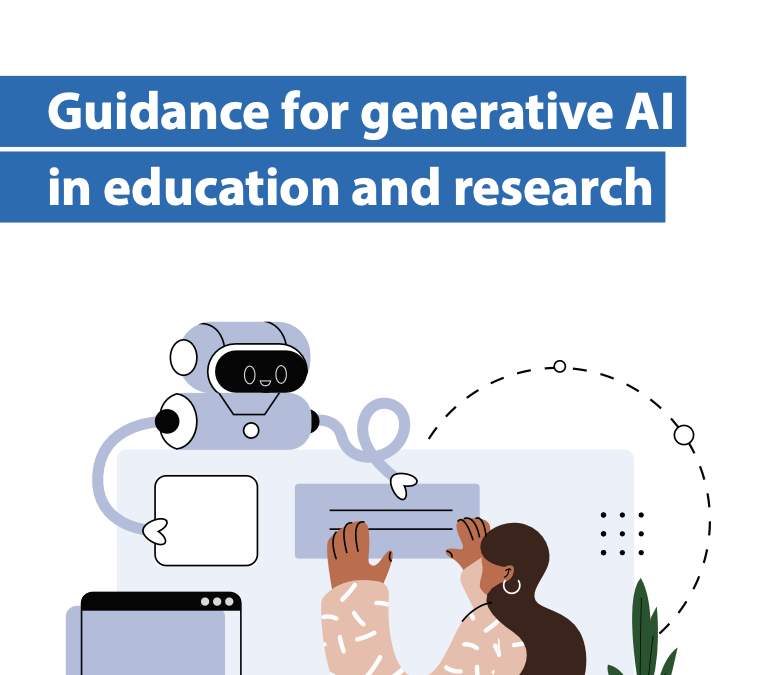Calm the Noise: 7 Ways to Meaningfully Integrate Generative AI in International Schools
By John Burns, ISS Chief Innovation Officer
Originally published in ISS NewsLinks, Volume XXXX, February 2024.
In the dynamic world of international education, embracing emerging technologies such as generative AI presents us with a range of challenges and opportunities. These tools have the potential to be transformative in many areas, offering new ways to enhance how we teach, learn, and operate. But it’s not just about adopting technology; it’s about reshaping educational experiences to be more inclusive, effective, and innovative.
Here are seven considerations for those interested in integrating generative AI in their context:
1. ‘Calm the Noise’
It’s easy to get overwhelmed by all the AI hype, particularly on social media, where if you’re not adopting bleeding edge technologies, you’re apparently “falling behind.”
In the recent ISS EDUlearn workshop Harnessing Generative AI to Support Multilingual Education, facilitator Ceci Gomez-Galvez offered a refreshing perspective. She emphasized the importance of centering efforts on the needs of those you directly impact; students, teachers, classes, communities, and/or school. This approach serves as a reminder to focus on practical and meaningful applications of AI in education, rather than getting swept away in the social media frenzy.
2. Recognize Inequity and Bias
This graph by the CSIRO vividly demonstrates just way one in which generative AI can continue to perpetuate existing biases. These models, trained predominantly on data from English-speaking and internet-rich regions, can echo these imbalances, sidelining non-English languages and diverse cultural narratives. In K-12 education, it’s critical we highlight and discuss these disparities with the wider community to ensure there is heightened awareness of the ways in which we should evaluate and apply these technologies.
3. Stay Informed
As AI continues to weave its way into the fabric of education, here are two solid reads worth checking out. First up, the U.S. Department of Education’s Artificial Intelligence and the Future of Teaching and Learning. It’s packed with insights on how AI can transform education via personalization, adaptivity, and feedback, while highlighting the importance of keeping “Humans-In-The-Loop.”
Then there’s UNESCO’s Guidance for generative AI in education and research, which does an effective job of providing high level provocations, policy advice, risk mitigation strategies, and discrete pedagogical practices.
4. Maximize Your AI Tool Experience
Navigating the world of AI tools can be both thrilling and complex. To truly harness their potential, consider these essential strategies:
Leverage Your Personal Expertise:
The key to effectively using AI tools lies in applying them within your own professional domains. When you have a firm grasp of the subject at hand, you’re better positioned to judge the accuracy and relevance of the AI’s output. Your expertise acts as a critical lens, helping you discern the veracity of the information provided, and what needs to be modified or excluded as a result.
Gain AI Experience:
Familiarity with AI grows through regular use. The more you interact with these tools, trying various prompts and approaches, the more adept you become at guiding the AI to produce the desired results. This experience is crucial for learning how to effectively communicate with and direct AI systems.
Have a Clear Vision:
Clarity about what you want to achieve with AI is essential. A well-defined goal or vision aids in formulating precise and purposeful prompts, leading the AI to generate responses that are better aligned with your objectives.
5. Tap into the Collective Wisdom
Design sprints can be an effective strategy for uncovering and expanding the practical applications of Generative AI in your respective context. These sessions should involve a diverse range of participants, including educators and administrative staff, and a dedicated block of time together. By guiding this community through this collaborative process, you can recognize existing professional expertise and create applications of AI that are truly beneficial to the entire organization.
6. Boost productivity with a new type of prompt
Navigating AI tools for content creation can be time-consuming, especially when it involves crafting prompts, reviewing outputs, and then refining responses for better results. To streamline this process and boost efficiency, consider utilizing an interactive prompt with simple numerical inputs. This approach not only saves time but also allows for easy customization to fit different educational contexts. Just copy/paste this prompt and give it a try. Also, feel free to modify it to better suit your task, role, or context.
7. Think BIG!
While exploring AI’s potential for productivity and learning design, it’s equally important to think ahead. Encourage conversations that push boundaries and envision the future of learning. How might we leverage AI as a lifelong mentor, for personalized learning pathways, real-time feedback, smart content generation, and more, while always keeping ‘Humans-in-the-loop’? It’s also essential to consider the influence that technology firms may have on the ways we leverage these tools in educational settings. Addressing these questions is crucial step in identifying applications of these technologies that align with our educational values and vision of learning.
Happy exploring!
Contact Us
ISS provides innovative professional development, school audits, and candidate recruiting for international schools around the world. Interested in learning more about how ISS can help with your needs? Drop us a line below and we’ll happily get back to you!
You can connect with John on LinkedIn or @j0hnburns on X.
If you’re interested in exploring more ways you can thoughtfully incorporate Generative AI into your educational context, check out the ISS EDUlearn® AI Bootcamp bundle. This package of three virtual professional development courses is offered for just $150 USD.


